When director Tom Hooper set out to make a new film version of the hugely popular musical Les Miserables, he faced one major hurdle: how could he tell the gritty story of French poverty, rebellion and love in a realistic way when:
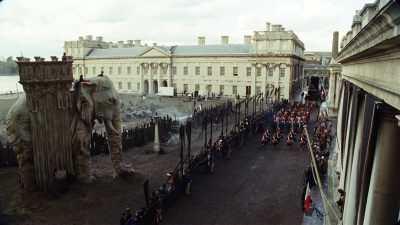

a) the cast would be singing, and
b) there was an already established theatrical legacy from the stage version of Les Mis.
The solution, from Hooper and the Les Mis filmmakers, was manifold:
1. First, Hooper had the actors sing each song live, rather than the usual process of lip sync’ing to pre-recorded vocal and orchestra tracks. Performers wore microphones while an on-set pianist played directly into concealed ear-pieces.
2. Instead of highly-staged musical numbers, such as those seen for example in the successful film version of Chicago (2002), Les Mis was shot mostly hand-held by DOP Danny Cohen on locations in France and Britain, including on elaborate sets at Pinewood Studios and Greenwich.
3. In addition, visual effects were used to flesh out scenes shot on stages and to re-create a photoreal version of early 19th century France.
fxguide takes a look at how the effects, in particular, helped the director tell the musical story, including selling key transitions between time and place during the film as the action moves forward.
The film’s opening shot
Les Mis begins in 1815 where, in the port of Toulon, scores of chain gang convicts including Jean Valjean (Hugh Jackman) are seen dragging a storm-damaged man-of-war ship into a dry dock, while they sing ‘Look Down’, watched over by police inspector Javert (Russell Crowe).
Whilst that song certainly opens the stage musical, the ship staging was added by the director to create a sense of ‘theater’ in the cinema. “It was Tom Hooper’s creative decision to establish this movie this way,” says visual effects supervisor Richard Bain, who came onto the project with Double Negative. “He wanted to establish that the convicts are in the depths of despair, the worst place you could imagine. His idea was also to set up the feeling of God as a character, looking down on both these principal characters – Valjean and Javert.”
The result is a dramatic scene serving to introduce the two main characters; indicate the hardship faced by the poor in France at the time; and, via the stormy seas, hint at the tumultuous turn of events that will impact on the characters of Les Mis.
The opening shot begins under a floating flag, before the camera breaches the water to reveal a stormy sky and sea, and then flies past the damaged ship to reveal the port and the struggling convicts, finally pushing into a head-and-shoulders view of Valjean. Co-visual effects supervisor Sean Mathiesen previs’d the initial move, with Double Negative also working to plan the lengthy shot. “Ultimately,” says Bain, “we set up an interactive Maya scene for Tom, so he could design the camera move himself. We sat him in front of a Maya scene and got him to design it.”
The final planned shot relied on just two live action plates; a crane move on the floating flag filmed on U stage at Pinewood, and then the back-end of the shot which was a crane move on Hugh Jackman and the chain gang acquired on a dry dock at Portsmouth. Everything in between relied on CG elements built by Dneg at both its London and Singapore offices.
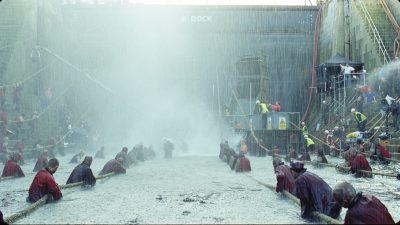
“Tom constantly referred back to a painting called Loss of the Magnificent by John Christian Schetky,” notes Bain. “In helping him establish what the shot was going to be, we did a concept painting based on the dry dock photography that he had sketched. We based it on that and then also researched etchings and paintings of Toulon at the time.”
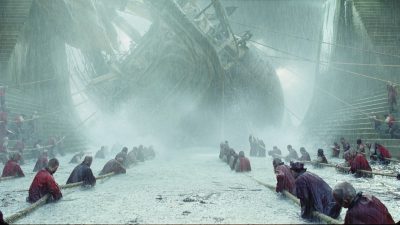
Double Negative modeled and textured a ship based on a LIDAR scan and textures taken of the HMS Victory located in Portsmouth. The dry dock used for shooting was also LIDAR’d and texture-shot, and footage of workers and convicts going through their actions later used as sprites for the final shots on land and even on board the ship. Dneg’s CG supervisors were Alison Wortman and Dan Neal, with 2D supervision by Ian Simpson.
A stormy ocean and environment surrounds the convict scene. At one point, Bain considered achieving the tumultuous seas by shooting real plates – something his Singaporean Dneg counterpart, visual effects supervisor Nathan McGuinness, had used previously on Master and Commander. “Nathan said there were storms in Australia at the time and that he could investigate areas to shoot stormy seas,” recalls Bain. “But we never shot anything in the end because by the time we designed the camera move, we couldn’t tell Nathan definitively what the move was going to be.” This meant that ultimately Dneg’s proprietary fluid sim tools dnOcean and Squirt were used for the water, mixed in with some live action elements filmed at Artem against greenscreen.
As the camera move continues towards Valjean, several chain gang members pulling on a rope are seen in the background. On location in Portsmouth, production had filmed extras in knee-deep water being lashed by dump tanks and enormous fans – something Dneg had to match in the wide shot. “One of the challenges,” recalls Bain, “was populating the convicts with the same action as we come in on the crane move, something we didn’t really want to do as CG.”
See how the dry dock scenes were filmed in this featurette.The one-cam system was originally developed by One of Us for the upcoming Jonathan Glazer film Under the Skin, in which the director wanted to put eight high quality digital cinema cameras in the cab of a van that could then be driven around by an actor, with the resulting footage being able to be seamlessly intercut with 35mm or digital.
So Dneg completed the convict shots with a photogrammetry approach, based on photography of select extras acquired with a six-camera one-cam array from One of Us. The one-cam is a purpose-built camera that splits the sensor (a CCD) from the recorder and so enables more cameras in the array shooting at high quality (2336 x 1752 pixels uncompressed 12bit RAW).
“We called it agent capture,” says Bain. “We took a sample range of convicts from the day of the shoot and got them to do their actions in front of a greenscreen set-up, which was a north facing area on a side of a building. We shot them with these synchronized cameras – the one-cams. The idea was that we could then do an optical flow build of that convict with textures embedded. That would give us a 30 degree variance in how we could approach the convicts.”
Getting from one place to another
A major story point has Valjean realizing that he must turn his convict-life around, with the action then propelling eight years forward to a different location where he has in fact found wealth and become mayor. Visual effects were once again relied on to tell this story, via a major transition.
As Valjean concludes his song ‘What Have I Done?’ in Digne, the action moves to Montreuil-sur-Mer workers singing ‘At the End of the Day’. For the transition, Dneg pieced together a soaring camera move heralding the eight year gap in which Valjean stands in a church yard of a mountain village, tears his parole papers and throws them aloft as the camera peers skywards. The shot follows the paper fragments into the heavens before falling back onto a group of riders, revealed to be Javert and his men entering Montreuil-sur-Mer.
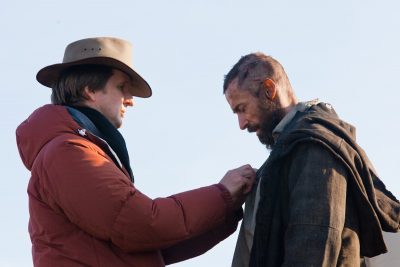
To achieve firstly the pullback from Valjean, the filmmakers staged the action at Ewelme’s Church in Oxfordshire. This crane shot then became a helicopter move based on an actual shoot in Gourdon in the French Alpes. “That plate was re-projected onto an environment built as a CG environment,” explains Bain, “then transitions to a matte painted sky up to the sun. The texture reference for the town, the church and graveyard is all from Oxfordshire.”
“When we pull out on Ewelme’s Church,” adds Bain, “the shot that Tom liked was the one where we were losing the light. So a lot of the lighting on the church was from a huge 10K light. It was very directional and Hugh was very side-lit – it looked like it was from a low sun. So we realized that if we were going to go up to the sun, the lighting on Hugh and the lighting on the church was ultimately wrong – so we had to lift everything up so it felt more evenly lit with the whole landscape.”
The camera then pushes down into Montreuil-sur-Mer, a pick-up from a crane shot on Russell Crowe’s face as he rides into town, filmed at Chatham, Kent – all composited by Double Negative. Later in Montreuil-sur-Mer, the ‘Lovely Ladies’ number made use of Dneg Singapore sky replacements for scenes that had been shot with a painted backdrop, another example of visual effects being used to enhance the Les Mis world.
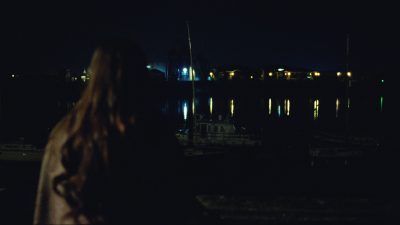
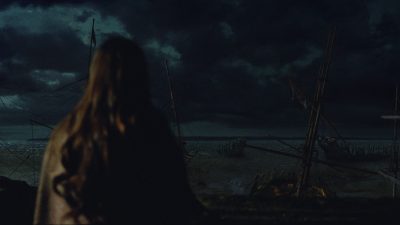
Creating Paris
The remainder of Les Miserables takes place in Paris. Hooper utilized location shoots from La Rochelle in France, the Old Royal Naval College in Greenwich and Pinewood Studios to re-create the city at the time.
Pledging to bring Valjean to justice, Javert sings ‘Stars’ against the backdrop of a sleeping city. Behind him, Dneg added the Parisian skyline including the Notre Dame and suitable building facades and rooftops. The transition following ‘Stars’ – originally more of a Paris fly-over – now careens over a cross atop the police building, looks into the skies where the stars disappear and then becomes a morning shot of the Place de la Bastille (filmed at Greenwich).
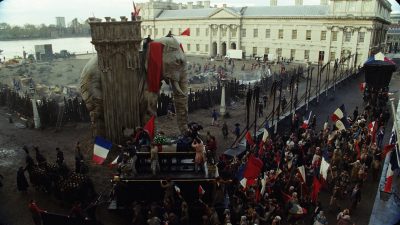
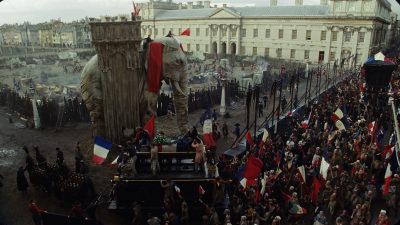
Place de la Bastille is also the site of General Lamarque’s funeral, which required set and crowd extensions. LIDAR and texture shoots from La Rochelle were used by Dneg to build geometry. For the crowds, Bain had originally planned to film multiple elements, for comp duplications, at the end of each day.
“But this was essentially flawed because production would shoot right up until the end of the day which meant that we would have had to do our crowd replication in the dark,” admits Bain. “So we decided to wait until the edit and then do our crowd rep shoot on the backlot at Pinewood under the same or similar lighting conditions.”
Dneg also created environments for Javert’s eventual suicide – filmed in a pickup shoot at Pulteney Weir in Bath. Artists combined greenscreen bridge footage of Russell Crowe from Pinewood with digital Paris surrounds for the final shots.
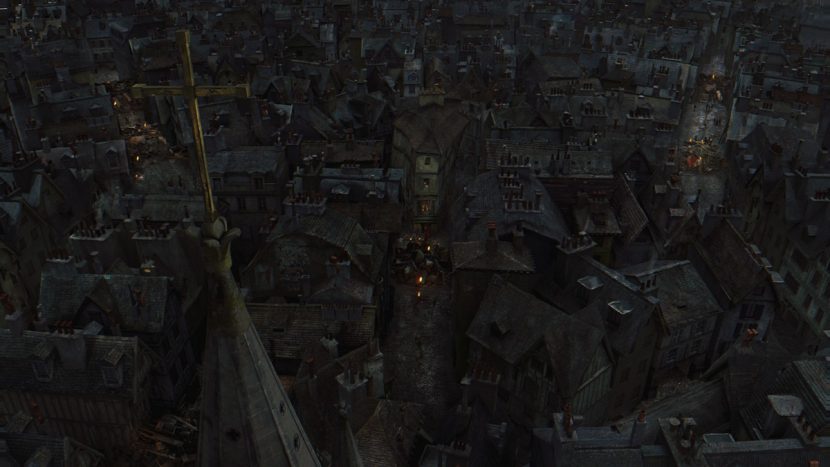
For later scenes at the student barricade, production filmed on the T stage at Pinewood, with The Mill completing various sky replacements and wide shots. “Tom was keen to sell the mood of each scene based on the skies,” recounts The Mill’s visual effects supervisor Sara Bennett. “The barricade shots were a lot of work, especially roto. The set lights meant that there were a lot of flares over all the set pieces, and it was quite a lot of work to remove those and then drop the skies in.”
The Mill worked on several other visual effects shots for the film, too. “The scene where Eponine is singing ‘On My Own’ is a poignant moment where it’s raining,” says Bennett. “The sky was a standalone sky. All the actual shot was lit for strong moonlight. In the novel Victor Hugo talks about God being an ever-present force so it’s quite Godly – Tom was keen on God-like skies. And then for the scene of Fantine’s ghost later on we enhanced the shot a little to make it more ethereal.”
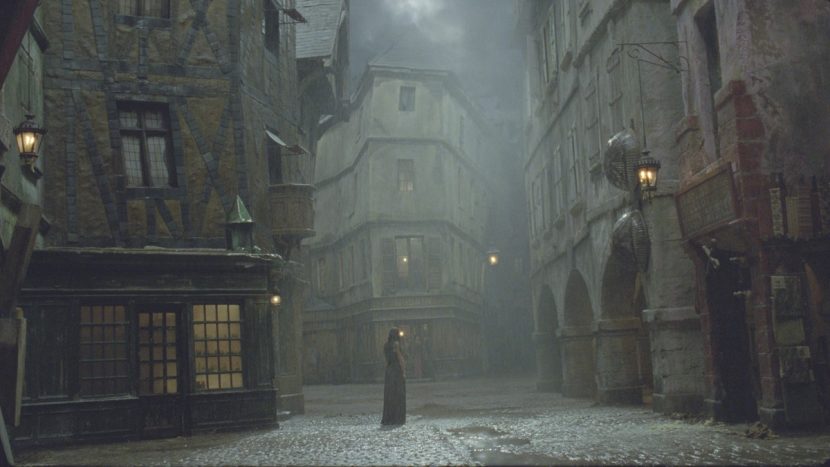
At the end of the day
Not only were visual effects artists helping to create oceans, ships, crowds and environments to tell the musical tale of Les Mis, they also had a direct impact on another of Hooper’s key approaches to making the magical reality of the show work as a film – they helped with the live singing. Several companies were required to paint out microphones and ear pieces, remnants of the live on-set singing set-up. In the end, that meant the VFX work really ranged from the invisible to the grand. “The opening shot really has that sense of theater,” says Bain, “but then a lot of the work we did was either to get you from A to B, or to recreate that era of France.”

(SPOILER ALERT) Did anybody else notice the strange effect just as Jarvert jumps off the bridge at the end? To me, there was a really jarring jump from the actor to the digital double. I thought the vfx for Les Mis were really strange to be honest.
Pingback: 레미제라블 메이킹 | Scene 27
Pingback: Working Title | TV Production Megan Worley